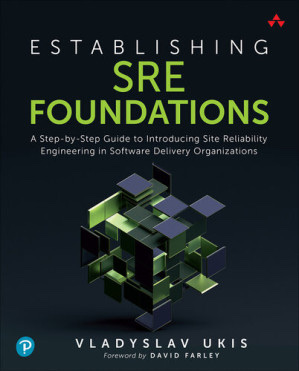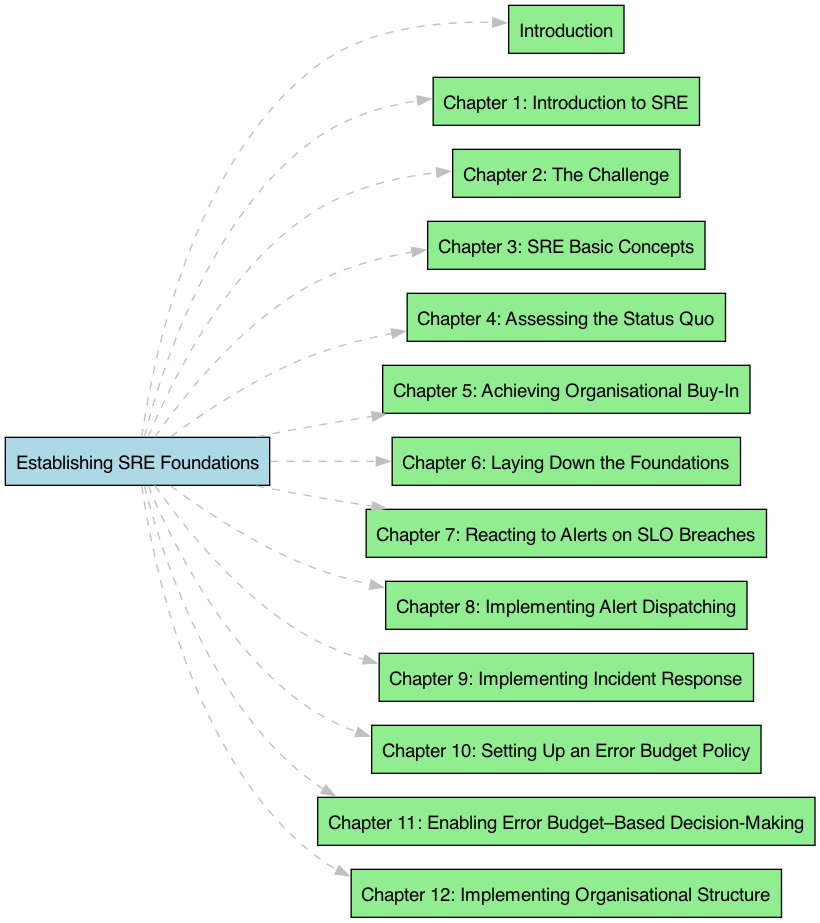Insights from Establishing SRE Foundations
"Establishing SRE Foundations: A Step-by-Step Guide" by Vladyslav Ukis provides a comprehensive framework for implementing Site Reliability Engineering (SRE) in software delivery organisations. Drawing from his extensive experience, Ukis outlines practical steps and methodologies to enhance reliability and operational efficiency in software systems.

Summary

Chapter 1: Introduction to SRE
The first chapter introduces the concept of Site Reliability Engineering (SRE) and its importance in modern software development. Ukis discusses the evolution of SRE, comparing it with other IT management frameworks such as ITIL, COBIT, and DevOps. The chapter sets the stage by explaining why SRE is crucial for aligning development and operations towards a common goal of reliability.
Chapter 2: The Challenge
Ukis identifies the common challenges organisations face when trying to improve reliability. He emphasises the issues of misalignment and collective ownership, explaining how SRE addresses these challenges by fostering a culture of shared responsibility. The chapter also covers the roles of product development, operations, and management in achieving SRE goals.
Chapter 3: SRE Basic Concepts
This chapter dives into the foundational concepts of SRE, including Service Level Indicators (SLIs), Service Level Objectives (SLOs), and Error Budgets. Ukis provides detailed examples and practical advice on how to define and measure these metrics to ensure that reliability targets are met without compromising on development velocity.
Chapter 4: Assessing the Status Quo
Ukis guides readers through a comprehensive assessment of their current organisational state. He discusses the importance of understanding the existing structure, technology stack, culture, and processes before embarking on an SRE transformation. The chapter includes a maturity model to help organisations gauge their readiness for SRE.
Chapter 5: Achieving Organisational Buy-In
Securing organisational buy-in is critical for SRE success. Ukis offers strategies for engaging stakeholders at all levels, from top executives to individual team members. He discusses how to build a compelling case for SRE and gain the necessary support to drive the transformation.
Chapter 6: Laying Down the Foundations
In this chapter, Ukis outlines the steps to establish the basic foundations of SRE. Topics include setting up introductory talks, conveying the basics of SRE to teams, standardising SLIs, and enabling logging and monitoring. He also covers how to define initial SLOs and engage champions to drive the adoption of SRE practices.
Chapter 7: Reacting to Alerts on SLO Breaches
Ukis provides a detailed framework for handling alerts and responding to SLO breaches. He discusses the roles and responsibilities of development and operations teams in managing incidents, setting up on-call rotations, and using professional on-call management tools. The chapter also emphasises the importance of systematic knowledge sharing and creating effective runbooks.
Chapter 8: Implementing Alert Dispatching
This chapter focuses on creating an efficient alert escalation policy. Ukis explains how to define stakeholder groups, trigger notifications, and implement an effective alert dispatching system. He also highlights the importance of continuous improvement and broadcasting success stories to maintain momentum.
Chapter 9: Implementing Incident Response
Ukis discusses the foundations of incident response, including prioritising incidents, coordinating complex incidents, and conducting effective postmortems. He provides practical advice on creating an incident response process that is both proactive and reactive, ensuring that lessons learned from incidents lead to continuous improvement.
Chapter 10: Setting Up an Error Budget Policy
Error budgets are a key component of SRE. Ukis explains how to set up an error budget policy, including defining error budget conditions, consequences, and governance. He provides guidelines on how to use error budgets to balance reliability and feature development effectively.
Chapter 11: Enabling Error Budget–Based Decision-Making
Ukis introduces a decision-making framework based on error budgets. He outlines various indicators and workflows to help teams make informed decisions about reliability and development priorities. The chapter includes practical examples and templates to guide implementation.
Chapter 12: Implementing Organisational Structure
The final chapter discusses how to structure the organisation to support SRE. Ukis explores different models, such as "You Build It, You Run It" and hybrid approaches, to help organisations find the best fit for their context. He also covers the importance of defining clear roles, career paths, and reporting lines to ensure sustained success.
Key Takeaways
- SRE Fundamentals: Understanding SLIs, SLOs, and error budgets is crucial for implementing SRE.
- Organisational Buy-In: Achieving support from all levels of the organisation is essential for a successful SRE transformation.
- Proactive Incident Management: Setting up effective incident response processes helps in managing and learning from failures.
- Continuous Improvement: Using error budgets and structured decision-making to balance reliability and development.
- Tailored Organisational Structure: Adopting the right organisational model to support SRE practices.
Personal Reflections
Reading "Establishing SRE Foundations" has provided me with a deeper understanding of how to implement SRE in a real-world context. Ukis’s detailed approach and practical advice make it an invaluable resource for anyone looking to improve their organisation's reliability. The emphasis on cultural and organisational change, alongside technical practices, highlights the holistic nature of successful SRE adoption.
Conclusion
"Establishing SRE Foundations: A Step-by-Step Guide" by Vladyslav Ukis is an essential read for anyone involved in software operations and development. It offers a clear, actionable roadmap for adopting SRE and transforming organisational practices to achieve higher reliability and operational excellence. By following the guidance in this book, organisations can navigate the complexities of SRE and create a more resilient software delivery process.